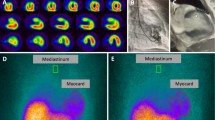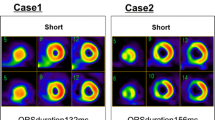Abstract
Objective
To explore the myocardial perfusion by thallium-201 scintigraphy for patients with evidence of myocardial damage after scorpion envenomation.
Design
Prospective study over 1-year period.
Setting
Medical intensive care unit of a university hospital (Sfax, Tunisia).
Patients
We have prospectively included six patients admitted for scorpion envenomation over a period of 1 year in the 22-bed intensive care unit (ICU) of our university hospital. The evidence of myocardial damage was confirmed by electrocardiography and echocardiography in all patients. Myocardial perfusion scintigraphy (201Tl scintigraphy) coupled with radionuclide ventriculography (99mTc) was performed for all patients, occurring 32 h on average (range 12–72 h) after the sting.
Results
Radionuclide ventriculography was abnormal in all cases; the abnormalities observed were similar to those observed by echocardiography. Moreover 201Tl scintigraphy showed evidence of myocardial hypoperfusion in all cases. The myocardial hypoperfusion grade and localisation were more marked in the abnormal localisation shown by echocardiography and electrocardiography, compared to the normal wall. Repeated studies, obtained only in two patients within 6 and 15 days, respectively, showed considerable, but not complete, improvement of wall motion and myocardial perfusion. Segments with improved perfusion showed greatly improved regional wall motion.
Conclusion
This study confirms the evidence of myocardial hypoperfusion after severe scorpion envenomation.



Similar content being viewed by others
References
Bahloul M, Bouaziz M, Dammak H, Ben Hamida C, Ksibi H, Rekik N, Chelly H, Teboul JL, Kallel H (2002) Value of the plasma protein and hemoglobin concentration in the diagnosis of pulmonary edema in scorpion sting patients. Intensive Care Med 28:1600–1605
Abroug F, Ayari M, Nouira S, Gamra H, Boujdaria R, Elatrous S, Ben Farhat M, Bouchoucha S (1995) Assessment of left ventricular function in severe scorpion envenomation: combined hemodynamic and echo-Doppler study. Intensive Care Med 2:629–635
Gueron M, Weizmann S (1969) Catecholamine excretion in scorpion sting. Isr J Med Sci 5:855–857
R Yarom, K Braun (1971) Electron microscopic studies of the myocardial changes produced by scorpion venom. Lab Invest 24:21–30
R Yarom, K Braun (1970) Cardiovascular effects of scorpion venom, morphological changes in the myocardium. Toxicon 8:41–46
Gueron M, Yaron R (1970) Cardiovascular manifestations of severe scorpion sting. Clinicopathologic correlations. Chest 57:156–162
Sansoy V, Glover DK, Watson DD, Ruiz M, Smith WH, Simanis JP, Beller GA(1995) Comparison of thallium-201 resting redistribution with technetium-99m—sestamibi uptake and functional response to dobutamine for assessment of myocardial viability. Circulation 92:994–1004
Gibson RS, Watson DD, Craddock GB, Crampton RS, Kaiser DL, Denny MJ, Beller GA (1983) Prediction of cardiac events after uncomplicated myocardial infarction: a prospective study comparing predischarge exercise thallium-201 scintigraphy and coronary angiography. Circulation 2:321–336
Brown KA (1991) Prognostic value of thallium-201 myocardial perfusion imagining. A diagnostic tool comes of age. Circulation 83:363–381
Green MV, Brody WR, Douglas MA, Borer JS, Ostrow HG, Line BR, Bacharach SL, Johnston GS (1978) Ejection fraction by count rate from gated images. J Nucl Med 19 (8):880–883
Elatrous S, Nouira S, Besbes-Ouanes L, Boussarsar M, Boukef R, Marghli S, Abroug F (1999) Dobutamine in severe scorpion envenomation: effects on standard hemodynamics, right ventricular performance and tissue oxygenation. Chest 116:748–753
Meki AR, Mohamed ZM, Mohey El-deen HM (2003) Significance of assessment of serum cardiac troponin I and interleukin-8 in scorpion envenomed children. Toxicon 41:129–137
Wang R, Moreau P, Deschamps A, de Champlain J, Sauve R, Foucart S, Bai L, Lu XR (1994) Cardiovascular effects of Buthus martensii (Karsch) scorpion venom. Toxicon 32:191–200
Gueron M, Margulis G, Sofer S (1990) Echocardiographic and radionuclide angiographic observations following scorpion envenomation by Leiurus quinquestriatus. Toxicon 28:1005–1009
Rahav G, Weiss AT (1990) Scorpion sting-induced pulmonary edema. Scintigraphic evidence of cardiac dysfunction. Chest 97:1478–1480
Margulis G, Sofer S, Zalstein E, Zucker N, Ilia R, Gueron M (1994) Abnormal coronary perfusion in experimental scorpion envenomation. Toxicon 32:1675–1678
Sofer S, Shahak E, Slonim A, Gueron M (1991) Myocardial injury without heart failure following envenomation by the scorpion leirus quinquestriatus in children. Toxicon 29:382–385
Ismail M, Osman O H, Petkovic D (1976) Electrocardiographic studies with scorpion ( Buthus Minax, L. Koch) venom. Toxicon 14:79–83
Silveira NP, Moraes-Santos T, Azevedo AD, Freire-Maia L (1991) Effects of Tityus serrulatus scorpion venom and one of its purified toxins (toxin gamma) on the isolated guinea-pig heart. Comp Biochem Physiol C 98:329–336
Pezard P, Jallet P(1998) Myocardial viability. Study of viability by myocardial scintigraphy. Presse Med 27:1043–1049
Simons M, Downing SE (1985) Coronary vasoconstriction and catecholamine cardiomyopathy. Am Heart J 109:297–304
Fukuhara YD, Reis ML, Dellalibera-Joviliano R, Cunha FQ, Donadi EA (2003) Increased plasma levels of IL-1beta, IL-6, IL-8, IL-10 and TNF-alpha in patients moderately or severely envenomed by Tityus serrulatus scorpion sting. Toxicon 41:49–55
Klemm P, Warner TD, Hohlfeld T, Corder R, Vane JR (1995) Endothelin 1 mediates ex vivo coronary vasoconstriction caused by exogenous and endogenous cytokines. Proc Natl Acad Sci U S A 92:2691–2695
Kadokami T, Shimokawa H, Fukumoto Y, Ito A, Takayanagi T, Egashira K, Takeshita A (1996) Coronary artery spasm does not depend on the intracellular calcium store but is substantially mediated by the protein kinase C-mediated pathway in a swine model with interleukin-1 beta in vivo. Circulation 94:190–196
Author information
Authors and Affiliations
Corresponding author
Rights and permissions
About this article
Cite this article
Bahloul, M., Ben Hamida, C., Chtourou, K. et al. Evidence of myocardial ischaemia in severe scorpion envenomation. Intensive Care Med 30, 461–467 (2004). https://doi.org/10.1007/s00134-003-2082-7
Received:
Accepted:
Published:
Issue Date:
DOI: https://doi.org/10.1007/s00134-003-2082-7




